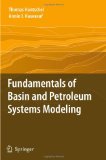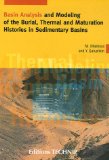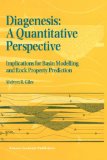Basin modeling
- 2D Basin Modelling and Petroleum System Analysis of the Triassic Play in the Hammerfest Basin of the Norwegian Barents Sea

- 3D-Basin Modelling of the Lishui Sag: Research of Hydrocarbon Potential, Petroleum Generation and Migration

- A coupled petrological±tectonic model for sedimentary basin evolution: the influence of metamorphic reactions on basin subsidence

- A Multidimensional Basin and Petroleum Systems Modelling Study in an Overthrust Setting – the Alpine Molasse Basin, Austria

- Analyzing the Thermal History of Sedimentary Basins: Methods and Case Studies

- Basin Analysis and Petroleum System Characterization and Modeling, Interior Salt Basins, Central and Eastern Gulf of Mexico

- Basin and Petroleum System Modeling

- Basin and Petroleum Systems Modeling at the Jeanne d'Arc and Carson Basin offshore Newfoudland, Canada

- Basin modelling

- Breakthrough in basin modeling using time/space frame

- Burial and thermal history modeling and petroleum potential evaluation of the northwestern Niger Delta, Nigeria

- Burial and uplift history of the Palaeozoic Flysch in the Variscan foreland basin (SE Bohemian Massif, Czech Republic)

- Effects of Sedimentary Heterogeneity on Hydrocarbon Accumulations in the Permian Ordos Basin, China: Insight From an Integrated Stratigraphic Forward and 3D Petroleum System Modelling

- Evaluating the Thermal History of the Los Angeles Basin through 3D Basin and Petroleum System Modeling

- Exploration Paradigm Shift: The Dynamic Petroleum System Concept

- Exploration Risk Assessment Using Forward Stratigraphic Modelling: Flemish Pass Basin, NL, Canada

- Forward Stratigraphic Modelling of Deep-Sea Sedimentary Environments: Predicting Facies Distribution in Salt Tectonics Context

- Geological Evolution And Basin Models During Neotectonic Episode In The Eastern Anatolia

- Geological Evolution of the North Sea: Cross-border Basin Modeling Study on the Schillground High

- Heat and Fluid Transport in the Vicinity of the Corsair Growth Fault Zone, Texas Continental Shelf, Gulf of Mexico

- Hydrocarbon Seepage And Carbonate Mound Formation: A Basin Modelling Study From The Porcupine Basin (Offshore Ireland)

- Incorporating Complex Geology in Basin Models: Example from a Forearc Basin; San Joaquin Valley, California

- Integrated Petroleum System Modeling to Evaluate Frontier Basins and Resource Plays

- Integrated Stratigraphic and Petroleum System Modeling Study of the Southern Upper Rhine Graben

- Linking Geostatistics With Basin And Petroleum System Modeling: Assessment Of Spatial Uncertainties

- Linking rock physics and basin history - Filling gaps between wells in frontier basins

- Modeling Permian Petroleum System of Northeast Netherlands: Hydrocarbon Generation and Migration

- Modeling Petroleum Generation in the Southern Muglad Rift Basin, Sudan

- New approach to basin formation temperature modelling

- Numerical basin modeling and tectonics
- Organic maturation within the Central Northern Calcareous Alps (Eastern Alps)

- Paleozoic petroleum systems of northern Germany and adjacent areas: A 3D modeling study

- Petroleum System

- Petroleum System Modeling in the Interior Salt Basins, North Central and Northeastern Gulf of Mexico

- Petroleum System Modeling and Exploration Potential of Abu Sufyan Sub-Baisn, Muglad Basin, The Republic of Sudan

- Petroleum Systems Modelling of the Perth Basin, Western Australia

- Petroleum Systems Modeling of the Salt Province and Outer Margin Offshore Essaouira (Atlantic Margin of Morocco)

- Quantitative models of sedimentary basin filling

- Relating Petroleum System & Play Development to Basin Evolution - South Atlantic Marginal Basins

- Research On Tectono-thermal Evolution Modeling Method For Superimposed Basin With The Jianghan Basin As An Example

- Seismo-stratigraphy and numerical basin modeling of the southern Brazilian continental margin (Campos, Santos, and Pelotas basins)

- Stanford University - Basin and Petroleum System Modeling Group
- Stress and Strain modelling of the Central European Basin System

- Structure, stratigraphy, and hydrocarbon system of a Pennsylvanian pull-apart basin in north-central Texas

- Thermal evolution of sedimentary basins and its effect on the maturation of hydrocarbons

- Thermal Structure of the Central Scotian Slope: Sea Floor Heat Flow and Thermal Maturation Models

- Three-Phase Darcy Migration in Basin Modeling

- Time-dependent thermal state of the lithosphere in the foreland of the Eastern Carpathians bend. Insights from new geothermal measurements and modelling results

- Using basin modeling for geothermal energy exploration in the Netherlands - an example from the West Netherlands Basin and Roer Valley Graben

- Utah University - Sedimentary Basins Research Group
Books about basin modeling




